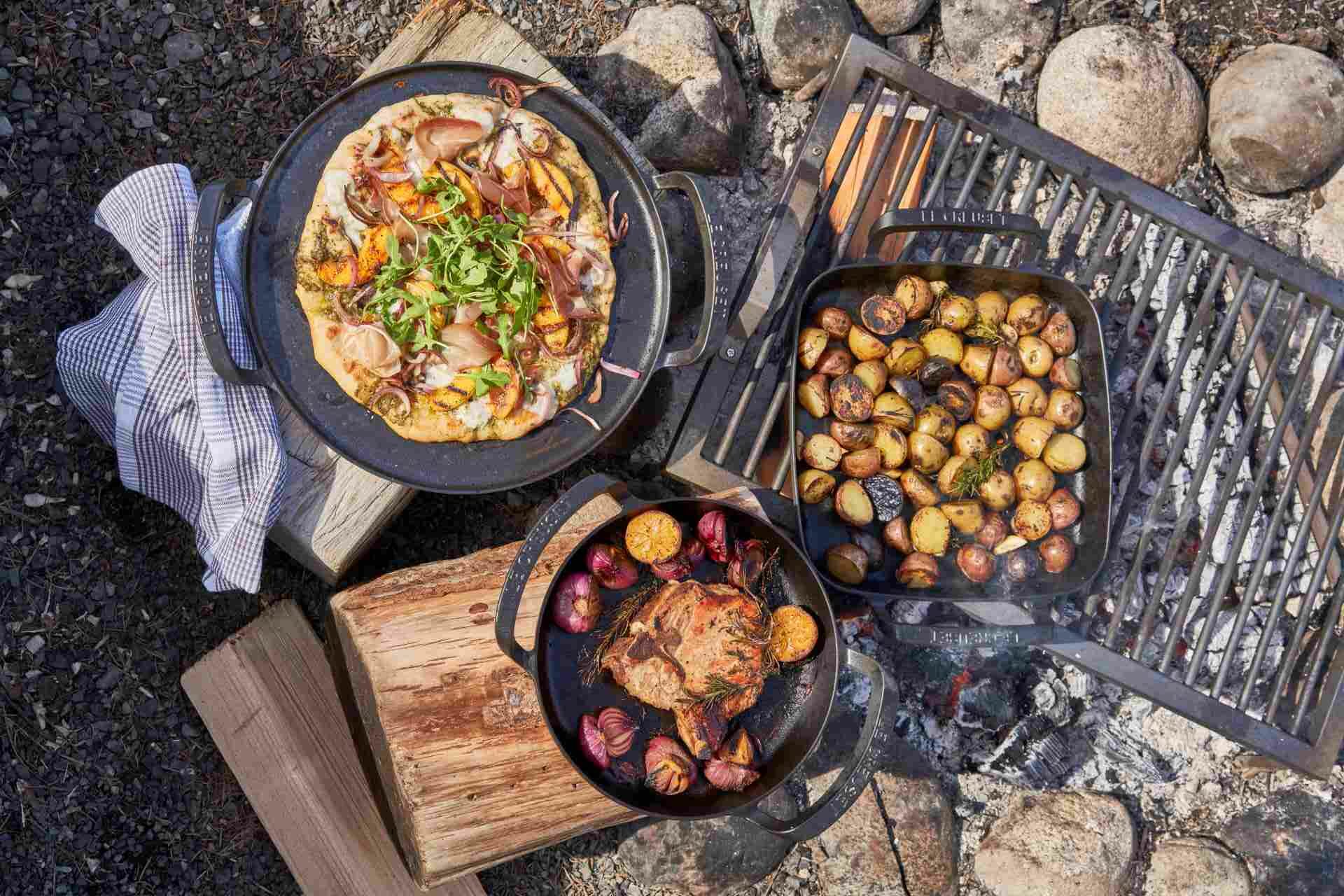Your morning brew, made by you, perfected by Breville.


Cast iron cookware is tough, versatile and just gets better with age—perfect for everything from searing a juicy steak to baking fluffy cornbread. Whether you’re cooking a slow-simmered stew or trying out a new recipe, cast iron pans deliver consistent results every time.
The benefits of cast iron go beyond just durability. These pans are champions at retaining and distributing heat evenly, which means no more hot spots burning your pancakes. Plus, a well-seasoned cast iron skillet is naturally nonstick, which makes cleanup easier.
Ready to get the most out of these kitchen powerhouses? In this article, we’ll uncover key tips and tricks on how to cook with a cast iron skillet effectively. From selecting the right piece to perfecting your seasoning technique, discover how to master your cast iron cookware and make it a true star in the kitchen.
Hungry for more? Shop our selection of top-of-the-line Cast Iron Cookware, from brands you love, including Lodge, Staub and Le Creuset!
Before diving into the techniques and tips for cooking with cast iron, it’s important to understand the differences between the types of cast iron available: raw, pre-seasoned and enameled. Each type has its own characteristics and care requirements, which can influence your cooking style and maintenance routine.
Raw cast iron is the most traditional form of cast iron cookware. It comes without any protective coating or pre-seasoning, presenting a bare metal surface. This type requires seasoning before first use to create a nonstick surface and to prevent rust.
Seasoning raw cast iron involves coating it in a layer of oil and baking it to polymerize the oil. This process needs to be repeated periodically to maintain its cooking properties and protective layer.
Related: “How To Clean and Season Your Cast Iron Skillet”
Pre-seasoned cast iron cookware is a convenience-focused choice. It arrives with an initial layer of seasoning applied by the manufacturer. This pre-seasoning means you can use the cookware right out of the box, although many cooks prefer to add additional layers of seasoning to enhance its nonstick properties.
Pre-seasoned cast iron still requires regular maintenance, similar to raw cast iron, to keep the seasoning refreshed and the cookware in optimal condition.
Enameled cast iron offers a different approach.
It features a vitreous enamel glaze which covers the iron, preventing rust and eliminating the need for seasoning. The enamel coating reduces the pan’s tendency to stick but doesn’t create the same nonstick surface as a well-seasoned traditional skillet.
Enameled cast iron is great for cooking acidic foods, which can damage the seasoning on non-enameled pans. However, it generally requires more careful handling to avoid chipping the enamel.
The seasoning on a cast iron skillet is what gives it its nonstick properties and helps protect against rust. For raw and pre-seasoned cast iron, maintaining the seasoning is key.
After each use, clean your skillet, dry it thoroughly and apply a light coat of vegetable oil. Heat the skillet on the stove over low heat for a few minutes to help the oil polymerize. This regular maintenance ensures your skillet stays nonstick and rust-free for all your cooking adventures.
Cast iron is known for its ability to retain heat, but it should be heated gradually to prevent damage. Start with a low flame and gradually increase to the desired temperature.
This method helps prevent hot spots and ensures an evenly heated surface, which is essential for cooking foods evenly and achieving perfect results every time.
One key to successful cast iron cooking is the use of sufficient fats, such as butter or oil. These fats not only help prevent food from sticking to the pan, but also contribute to the overall flavor and texture of the dish.
For dishes where a crispy edge or crust is desirable, such as pancakes, cornbread or hash browns, don’t shy away from a generous amount of butter or oil. It creates a delicious, crispy layer that is a hallmark of well-prepared cast iron cooking.
When cooking with cast iron, consider the type of fat based on the cooking temperature and flavor you’re aiming for.
For high-heat cooking, oils with high smoke points, like canola or grapeseed oil, are preferable to prevent burning. For lower temperatures or when flavor is paramount, butter or olive oil can be excellent choices.
This liberal use of fats not only enriches flavors but also plays a crucial role in maintaining the skillet’s seasoning over time, contributing to its nonstick properties.
Cast iron skillets are ideal for searing meats due to their ability to hold high heat.
To achieve a perfect sear, ensure your skillet is very hot before adding the meat. This will help ensure the surface caramelizes quickly, locking in juices and flavors. Make sure the meat is dry and seasoned right before it goes into the pan to prevent sticking and ensure a crispy exterior.
To protect the seasoning layer, use utensils that won’t scrape or damage the surface.
While metal utensils can be used carefully, wooden or silicone utensils are better choices. They are gentle on the cookware and still sturdy enough to handle the weight and movement of food being cooked.
Soaking cast iron in water can lead to rusting, which deteriorates the skillet’s seasoning and overall quality.
If you need to remove stuck-on food, boil some water in the pan for a few minutes to help loosen the residue, then clean it with a non-abrasive brush or scraper. You can also scrub it with hot water and a brush or coarse salt right after cooking to avoid rust and maintain the seasoning.
After washing, it’s crucial to dry your cast iron thoroughly to prevent rust. Place the skillet on a stove over low heat to evaporate any remaining moisture. Once it’s completely dry, apply a thin layer of oil to protect the surface before storing. This step is vital to ensure the longevity and performance of your cast iron.
Enameled cast iron provides the benefits of cast iron without the need for seasoning. However, it requires careful handling to avoid chipping the enamel.
Use low to medium heat to prevent thermal shock and potential cracking. Since enamel is less prone to sticking, it’s excellent for cooking acidic dishes that can strip the seasoning from traditional cast iron.
Proper storage of your cast iron cookware can prevent damage and extend its life. If you must stack your skillets or other pots, place a layer of paper towel or a soft cloth between them to prevent scratches and to absorb any moisture. Ensure your storage area is dry to avoid any rust formation.
Due to its weight and ability to retain heat, always handle cast iron cookware with care. Use oven mitts when touching hot handles or moving the skillet from one surface to another.
Be cautious when transferring a full skillet, as the weight can be significant, and always place it on a protected surface to avoid damage.
Avoid cooking acidic foods like tomatoes in uncoated cast iron, as they can strip the seasoning. Similarly, don’t store food in cast iron for extended periods to prevent a metallic taste.
While trace amounts of iron transfer from the skillet to your food and are generally beneficial, they are safe for most people.
Cast iron is incredibly versatile—perfect for frying, searing, baking and even grilling. Its ability to go from stove to oven makes it ideal for recipes that require multiple cooking methods. Use it on the barbecue or over an open fire for added flavor.
Regular use is the best way to maintain your cast iron’s seasoning. Each use builds up the nonstick surface, enhancing the skillet’s performance and flavoring capabilities. Embrace daily cooking with your cast iron to keep it in prime condition.
Finally, the key to mastering cast iron cooking is practice and patience. Learn how your skillet reacts to different foods and cooking methods. Each skillet is unique, and time will teach you how to achieve the best results with your specific piece of cookware.
Hungry for more? Shop our selection of top-of-the-line Cast Iron Cookware, from brands you love, including Lodge, Staub and Le Creuset!
Join The Conversation